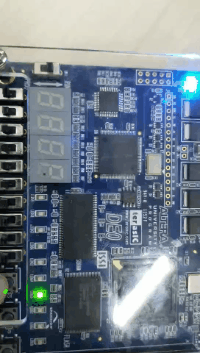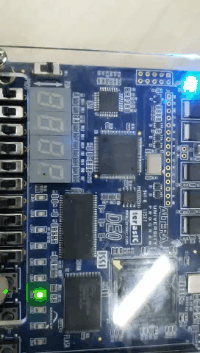首先写出Verilog代码如下:
//////////////////// 串入并出移位寄存器 /////////////////////////
module shift_reg_SIPO(
RST , // 异步复位, 高有效
CLK , // 时钟,上升沿有效
EN , // 输入数据串行移位使能
IN , // 输入串行数据
OUT , // 并行输出数据
DIR); // 方向选择,DIR=1时左移,DIR=0时右移
parameter SHLEN = 6;
input RST, CLK, EN;
input IN,DIR;
output[SHLEN-1:0] OUT;
reg [SHLEN-1:0] shift_R;
assign OUT[SHLEN-1:0] = shift_R[SHLEN-1:0];
// 时序逻辑 根据输入使能进行串行移位
// shift_R 会被编译为D触发器
always @ (posedge CLK or posedge RST) begin
if(RST)
shift_R[SHLEN-1:0] <= 0;
else
if(EN&&DIR) begin // 串行移位的使能有效,左移
shift_R[SHLEN-1:1] <= shift_R[SHLEN-2:0];
shift_R[0] <= IN;
end
else if(EN==1&&DIR==0) begin // 串行移位的使能有效,右移
shift_R[SHLEN-2:0] <=shift_R[SHLEN-1:1];
shift_R[SHLEN-1] <= IN;
end
else begin // 使能无效保持不动
shift_R[SHLEN-1:0] <= shift_R[SHLEN-1:0];
end
end // always
endmodule
//////////////////// 时间基准计数器 /////////////////////////
module cnt_sync(
CLK , // clock
CNTVAL, // counter value
OV ); // overflow
input CLK;
output [32-1:0] CNTVAL;
output OV;
parameter MAX_VAL = 25_000_000;
reg [32-1:0] CNTVAL;
reg OV;
always @ (posedge CLK) begin
if(CNTVAL >= MAX_VAL)
CNTVAL <= 0;
else
CNTVAL <= CNTVAL + 1'b1;
end
always @ (CNTVAL) begin
if(CNTVAL == MAX_VAL)
OV = 1'b1;
else
OV = 1'b0;
end
endmodule // module cnt_en_0to9
////////////////////////////////////////////////////////////////////////////////
bdf原理图:
编译后,设置引脚,记住不用的引脚设为三态,
RTL Viewer:

编译下载后:
右移

左移:

验证了实验的正确性。
版权声明:本文为Python_banana原创文章,遵循 CC 4.0 BY-SA 版权协议,转载请附上原文出处链接和本声明。

